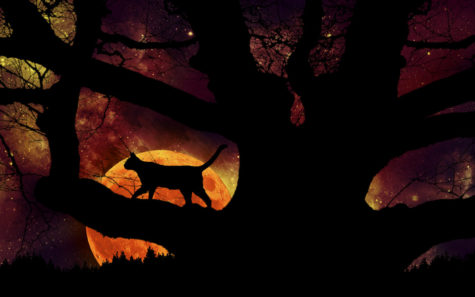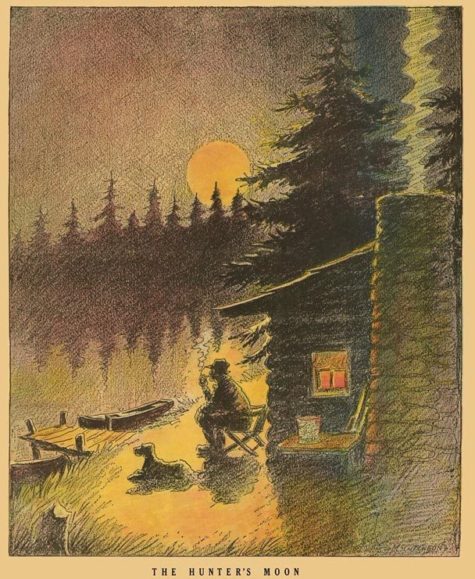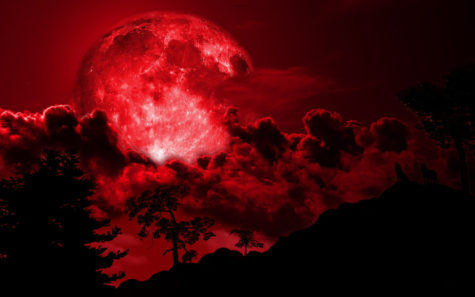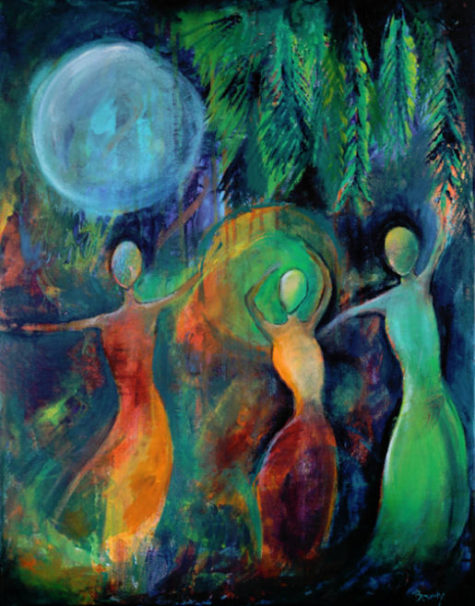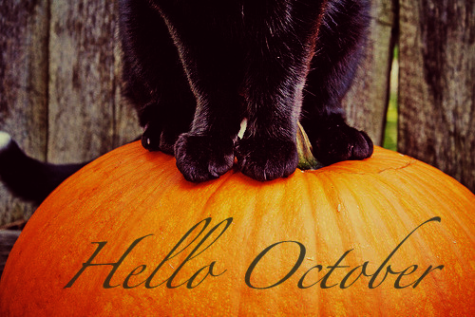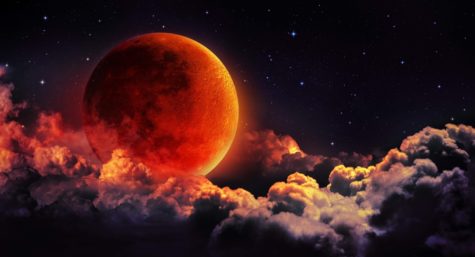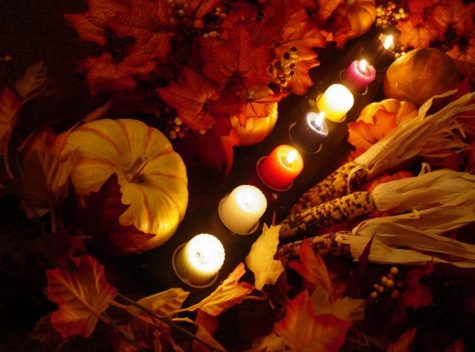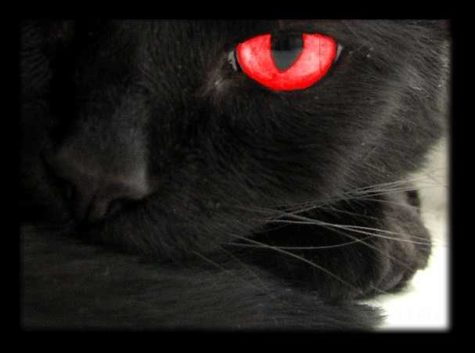October Lore
The Hunter’s Moon is so named because plenty of moonlight is ideal for hunters shooting migrating birds in Northern Europe. The name is also said to have been used by Native Americans as they tracked and killed their prey by autumn moonlight, stockpiling food for the winter ahead.
Traditional association with feasting:
In the northern hemisphere, the Hunter’s Moon appears in October or November, usually in October. Traditionally, it was a feast day in parts of western Europe and among some Native American tribes, called simply the Feast of the Hunter’s Moon, though the celebration had largely died out by the 18th century. There is a large historical reenactment by that name in Lafayette, Indiana during the early part of October 2010
Variation in time of moonrise:
In general, the moon rises about 50 minutes later each day, as it moves in orbit around Earth. All full moons rise around the time of sunset. The Harvest Moon (full moon closest to the Autumnal Equinox) and Hunter’s Moon are special because — as seen from the northern hemisphere — the time of moonrise on successive evenings is shorter than usual. The moon rises approximately 30 minutes later, from one night to the next, as seen from about 40 degrees N. latitude, for several evenings around the full Hunter’s or Harvest Moons.
Thus there is no long period of darkness between sunset and moonrise, around the time of these full moons. In times past, this feature of these autumn moons was said to help hunters tracking their prey (or, in the case of the Harvest Moon, farmers working in the fields). They could continue tracking their prey (or bringing in their crops) by moonlight even when the sun had gone down. Hence the name Hunter’s Moon.
The reason for the shorter-than-usual rising time between successive moon rises around the time of the Harvest and Hunter’s Moon is that the orbit of the Moon makes a narrow angle with respect to the horizon in the evening in autumn, leading the Moon to higher positions in the sky each successive day.
Brightness and distance:
The Hunter’s Moon is not brighter, smaller or yellower than during other times of the year, but all full moons have their own special characteristics, based primarily on the whereabouts of the ecliptic in the sky at the time of year that they are visible.
The full moons of September, October and November, as seen from the northern hemisphere — which correspond to the full moons of March, April and May as seen from the southern hemisphere — are well known in the folklore of the sky.
Since the Moon’s sidereal period differs from its synodic period, the perigee of the Moon (the point where it is closest to the Earth) does not stay in sync with the phases of the Moon. Thus the Hunter’s Moon does not correspond to any special timing of the Moon’s distance from the Earth. This is why the Hunter’s Moon is not, in general, brighter than any other regular full moon.
Source: Wikipedia
October’s full moon is often referred to as the Blood Moon, or Sanguine Moon. The Blood Moon takes its name not from blood sacrifices, but from the old custom of killing and salting down livestock before the Winter months made it impossible to feed them. Only the choicest stock was kept through the cold season.
The leaves are falling from trees, the deer are fattened, and it’s time to begin storing up meat for the long winter ahead. Because the fields were traditionally reaped in late September or early October, hunters could easily see fox and other animals that come out to glean from the fallen grains.
Coming right before Samhain, it’s a time when the nights are crisp and clear, and you can sense a change in the energy around you.
Correspondences:
- Colors: Dark blue, black, purples, Deep Blue Green
- Element: Air
- Scents: strawberry, apple blossom, and cherry
- Gemstones: Obsidian, amethyst, tourmaline, opal, beryl, turquoise
- Herbs: Apple blossom, pennyroyal, mint family, catnip, Sweet Annie, thyme, catnip, uva ursi, angelica, burdock
- Flowers: Calendula, marigold, cosmos
- Trees: Apples, yew, cypress, acacia
- Birds: Heron, crow, and robin
- Animals: Stag, jackal, elephant, ram, scorpion
- Nature Spirits: Frost and plant faeries
- Gods: Herne, Apollo, Cernunnos, Mercury, Ishtar, Astarte, Demeter, Kore, Lakshmi, The Horned God, Belili, Hathor
- Powers/Advice: A time to work on inner cleansing, letting go karma, reincarnation, justice and balance.
This is the time when the veil between our world and the spirit world are at its thinnest. Use this time for spiritual growth — if there’s a deceased ancestor you wish to contact, this is a great month to do it. Hold a séance, work on your divination, and pay attention to messages you get in your dreams.
Probably because of the threat of winter looming close, the Blood Moon is generally accorded with special honor, historically serving as an important feast day in both Western Europe and among many Native American tribes.
The Blood moon focuses around connecting with animals, and our animal totems and guides. Those who practice looking at the degrees of the lunar cycle may realize that this is the last time the moon will be at a later degree. This conjunction will allow many to look at life differently every time the new moon approaches and allowing us to look at past and the future at the same time.
This moon also forces us to look at love completely differently and ask the questions:
- What is love?
- Is the love you have unconditional?
That love does not have to be just in the areas of relationship but also our interaction with people, it can even be love of work and things you have acquired.
Additionally it means to be able to let it go of someone or something no matter how much you love it because it needs to be set free. The past years have reminded us that changes need to happen that this kind of life is no longer tolerant and peaceful. We will be reminded once again we can no longer walk in other people’s shadows.
Because this moon focuses around our animal nature, some of us may become very aggressive in what we say or do. It may cause many people to act out. This type of moon has been known for violence, suicides and domestic disputes over things that may or not exist – another reason it is known as the blood moon.
A Ritual For The Blood Moon
Here’s a nice little ritual to do for the Blood Moon.
You will need:
- A special glass or chalice – something pretty
- Rose water – or spring water
- White cotton cloth
- Red wine
- Ripe pomegranate
- Honey
- Silver spoon
For this ritual it will be nice to dress up a little. Wear white or silver, and if you have it, silver jewelry with carnelian, or moonstone. Use a special glass or chalice.
Rinse the chalice with rose water and dry it with a clean white cotton cloth. Pour the cup of red wine into the chalice, slice the pomegranate in half and squeeze the juice into the wine. Add a teaspoon of honey, and stir with the silver spoon.
Go outside. If you are doing this with friends, form a circle. Lift the chalice in the direction of the moon and say a few words of praise, thanks, appreciation, whatever feels appropriate and right. Then take a sip of the wine and pass the chalice clockwise around the circle (if there is one). Each person “toasts” the Blood Moon and drinks.
When the circle is complete, pour the rest of the wine on the ground as a “libation” or offering to the earth.
Collected from various sources including: PaganWiccan.About.Com, Art by Beverly Ash Gilbert.
In the ancient Roman calendar, October was the name of the eighth month of the year. Its name comes from octo, the Latin word for “eight.” When the Romans converted to a 12-month calendar, they tried to rename this month after various Roman emperors, but the name October stuck.
In Old England, the month was called Winmonath, which means “wine month,” for this was the time of year when wine was made. The English also called it Winterfylleth, or “Winter Full Moon.” They considered this full Moon to be the start of winter.
October Weather
A warm October is said to be a sign of a cold February. If leaves wither on the trees and fail to fall to the ground in autumn, it indicates a frosty winter with a great deal of snow, alternatively:
“If October brings heavy frosts and winds,
then will January and February be mild.”
The October Moons
The full moon closest to the Autumn Equinox is called the Harvest Moon, and as such, it sometimes falls in October. This moon is also called the Blood Moon, Hunters Moon, Shedding Moon or the Falling Leaf Moon. Coming right before Samhain, it’s a time when the nights are crisp and clear, and you can sense a change in the energy around you.
The Blood Moon takes its name not from blood sacrifices, but from the old custom of killing and salting down livestock before the Winter months made it impossible to feed them. Only the choicest stock was kept through the cold season.
Today we still subconsciously begin to make preparations for the coming Winter during this time. We check the antifreeze and tires for the car, gather up garden hoses, and make plans to winterize any drafty spots around doors and windows in the house. Some of us do and an ambitious fall cleaning.
October Magick
Throughout this month, festivals for the dead increase with the waning light, and late harvest festivals continue. The latter often include propitiation to ensure that the Goddess’s abundance will keep people whole through harsh or barren times.
Magical efforts accentuated by October’s characteristics include clearing away old, unnecessary things or habits so that our mind, body, and spirit are prepared for winter. Any spells for memory, especially commemorating loved ones, are apt. Beyond this, metaphysical efforts for health, luck, and debt paying seem common, ensuring that winter, the season of rest and death, will come and go with the least negative effect.
October Festivities
The Greek festival of Thesmophoria came every year in honor of Demeter and was confined to women only. This was a three-day rememberance of Kores return to the Underworld. At this festival the initiates shared a sacred barley drink and cakes. One feature of the Thesmophoria was a deterrent to offenders against the sacred laws against women. Priestesses read a list of the offenders before the doors of the goddesses’ temples, especially the temples of Demeter and Artemis. It was believed that anyone so cursed would die before the year ended.
The first day of the Thesmophoria was the kathodos, a ritual where purified priestesses took sacrificed piglets deep into the chasm where the sacred inner shrine of Demeter was. They left the piglets there and retrieved the remains of the one from the previous year. The second day was Nesteia, during which the remains of the retrieved piglets were displayed on the altar. Courts were closed in honor of Demeter as law-giver. On the third day, the retieved piglets were sown into the plowed Earth as a symbol of Demeter’s fertility aspect.
The Greeks also honored the god Hephaestus with an annual festival called Chalkeia.
In Tibet, the Buddhist Lent occured along with the Descent from Heaven festival which celebrated the end of the rainy season.
The Durga Puja in India honors the goddess Durga for four days beginning on the New Moon. It is a time of family reuntions, settling quarrels, and honoring the parents. In northern India this fesival is known as Dasahara. Durga is considered a matriarchal figure and is very popular with the people. She is shown with many arms and in bright colors.
The Lakshmi Puja, or Diwalii, is a fest of lights in honor of the goddess Lakshmi. It occurs right after the Durga Puja. During this Festival of Lights, lamos are everywhere, good things to eat are produced, and Hindu wives dance for their husbands. Lakshmi, wife of Vishnu, is considered the goddess of wealth and prosperity.
In the Pacific Ocean, the ancient Hawaiians celebrated a four-month long festival called Makahiki, beginning of the first Full Moon of this month. The god Lono had a special celebration of five days during this time, filled with games, pageantry, the hula, surfing, feasting, and tax collecting.
From:
According to the old roman calendar July 18 is a “dies ater” or black day, meaning a day of ill omen, or Day of Bad Omens. It marks the defeat of the Romans by the Gauls in the Battle Allia in 390 BC which in turn lead to the sack of Rome by the Gauls.
October 6 is also a “dies ater” or black day as it marks the anniversary of the battle of Arausio (105 BC).
Not much is said about the dos and don’ts or any rituals associated with either day, So, I thought it would be appropriate to post this excerpt from a little book called Signs Omens and Portents in Nebraska Folklore, published in 1933:
Signs of evil portent are among the most common of surviving folk beliefs in Nebraska. In number and currency they rival the popular omens concerned with weather and marriage and they are regarded with perhaps a greater degree of seriousness than signs of the latter type. Such a mass of superstitions having to do with death and bad luck hints at underlying pessimism in human beings. It suggests a preoccupation with the idea of death and a constant dread of inevitable calamity.
Possibly thoughts of melancholy are not so pervasive as the signs might lead us to believe, and it is reassuring to note that open credulity has almost disappeared. The mere survival of the signs, however, is a poignant reminder of a fear-ridden past, and such modern taboos as those against counting cars in a freight train and turning in a funeral car are evidence that superstitions are still in the making.
There is much confusion in the signs. Those which are regarded as bad luck omens by many people have become portents of death to others. The shift may be the result of a natural tendency to make omens specific rather than to leave them merely general indications of good or ill fortune.
Many of the signs seem to be based on a rather obvious association of ideas. Funerals bring to mind the common fate of man. Almost any incident connected with a burial may be looked upon as a sign of another death or an impending disaster. The hooting of an owl has an ominous sound. It causes a shudder, inspires fear, and becomes linked with thoughts of future afflictions. Although the howling dog may not as in legend see the goddess of death, he wakens with his mournful falsetto thoughts of gloom, and quite naturally may become to the superstitious a messenger of approaching distress.
Other signs indicate the connection between ignorance and fear, the tendency to look with dread upon the unknown, and to find in the unusual cause for anxiety. The most commonplace occurrence may become a menace, if it takes place at an unexpected time. When standards of appropriateness are violated, when the incongruous is noted, suspicion and fear are aroused.
In such signs the psychological basis seems obvious enough. In others the roots of belief are more difficult to suggest. Possibly the Romans are responsible for many omens associated with birds; the belief in the ill luck attendant upon salt-spilling may come from the Jewish and pagan use of salt in sacrificial rites, and the fear inspired by breaking a mirror may be traced to the use of mirrors by magicians in sorcery. But the origin of many of the symbols seems lost to us entirely. Like the events they predict, they are obscure, and they are perhaps more interesting because of the element of mystery which surrounds them.
